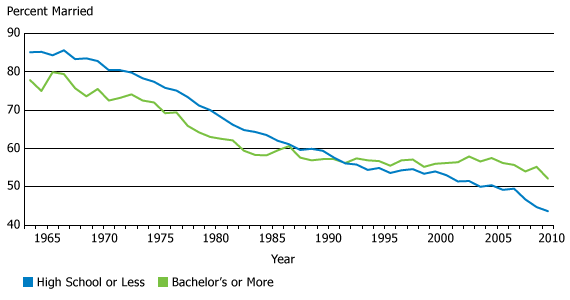Mark Mather
Associate Vice President, U.S. Programs

September 28, 2010
Associate Vice President, U.S. Programs

Former Intern
(September 2010) Marriage rates have dropped precipitously among young adults ages 25 to 34 during the past decade and the decline has accelerated since the onset of the recession, according to PRB’s analysis of new data from the U.S. Census Bureau’s 2009 American Community Survey (ACS) and 2010 Current Population Survey (CPS). The data suggest that more young couples are delaying marriage or foregoing matrimony altogether, likely as an adaptive response to the economic downturn and decline in the housing market.
Between 2000 and 2009, the share of young adults ages 25 to 34 who are married dropped 10 percentage points, from 55 percent to 45 percent, according to ACS data.1 During the same period, the percentage who have never been married increased sharply, from 34 percent to 46 percent. In a dramatic reversal, the proportion of young adults in the United States who have never been married now exceeds those who are married.
| 2000 | 2006 | 2007 | 2008 | 2009 | |
|---|---|---|---|---|---|
| Married | 55.1 | 48.9 | 48.2 | 46.9 | 44.9 |
| Never Married | 34.5 | 41.4 | 42.6 | 43.9 | 46.3 |
Source: U.S. Census Bureau, 2000 Census and American Community Survey.
Among the total population ages 18 and older, the proportion married dropped from 57 percent in 2000 to 52 percent in 2009. This is the lowest percentage recorded since information on marital status was first collected by the U.S. Census Bureau more than 100 years ago.2 Among women, the proportion married dropped below 50 percent (to 49.9 percent), so the number of unmarried women (including those who are separated, widowed, divorced, and never married) outnumber married women, possibly for the first time in U.S. history. In 2009, there were an estimated 59.5 million adult women who were married, compared with 59.8 million women in other marital categories.3
Many people who are classified as single are actually in cohabiting relationships with opposite- or same-sex partners. In fact, the sharp decline in marriage has been accompanied by a rapid increase in the number of cohabiting couples, as reported by the U.S. Census Bureau in September, 2010.4 Cohabitation has been on the rise for several decades, but the Census Bureau links the recent increase in cohabiting couples to rising unemployment rates and growing economic uncertainty, especially among young men. Given the scope of the recent recession, many more couples are likely to choose cohabitation over marriage in the coming years.
Results from the Census Bureau’s CPS, released in September 2010, show that the decline in marriage rates continued in 2010.5 Marriage rates have dropped among all major racial/ethnic groups and for both men and women. However, there are substantial differences in marriage trends by level of education. CPS data show that those with only a high school diploma (or less) have experienced a steep decline in marriage during the past decade. In contrast, marriage rates have held fairly steady for those with at least a bachelor’s degree.
Between 2000 and 2010, the proportion of young adults who are married dropped 10 percentage points (to 44 percent) for those with a high school diploma or less. For those with at least a bachelor’s degree, the percent married dropped only 4 percentage points, to 52 percent. This divergence in trends has led to a growing “marriage gap” between those at different ends of the educational scale.6
The marriage gap used to be reversed. Prior to the 1990s, marriage rates among those with a high school diploma or less were higher than those with a four-year college education. The college-educated were more likely to postpone marriage compared with those in less-educated groups. Marriage rates today look very different, with higher proportions of young, highly educated adults entering formal unions, and a sharp drop among those with less education.

Source: U.S. Census Bureau, 2000 Census and American Community Survey.
Marriage used to be a near-universal phenomenon in the United States. Estimates from the mid-1960s show marriage levels of 80 percent or more among young adults ages 25 to 34. Starting in the 1970s, several factors contributed to a steady decline in marriage, including rising divorce rates, an increase in women’s educational attainment and labor force participation, and a rise in cohabitation as an alternative or precursor to marriage. Although marriage rates have dropped among young adults, it is important to note that most young adults will go on to marry later in life. The probability of an adult getting married at some point during their lifetime is still nearly 90 percent.7
Another factor contributing to the decline in marriage rates, especially for less educated groups, is the rise in women’s earnings relative to men. Family demographers point out that as women’s wages have increased, fewer women rely on a spouse or partner to provide a weekly paycheck. Women now outnumber men in U.S. colleges, and a recent report by the Pew Research Center showed that there is a rapidly growing number of women who outearn their husbands.8 Demographer Andrew Cherlin argues that women’s higher earning capacity, and the declining economic prospects of young men without a college degree, are key factors contributing to the decline in marriage in recent years.9 The recession has exacerbated this trend because of its disproportionate impact on men with fewer job skills and less education.10
Since 2000, the proportion married has declined in every state. However, several states in the Northeast and Southwest experienced bigger declines than others. Arizona, Maine, New Hampshire, and Vermont were among the top-10 states with the largest decreases in marriage among young adults from 2000 to 2009. States where marriage rates remained relatively stable include several in the Midwest and Mountain West—Colorado, Idaho, Iowa, North Dakota, South Dakota, Utah, and Wyoming.
These state-level results suggest that rising unemployment rates may have contributed to regional marriage patterns, but that it was not the only factor. In Rhode Island, for example, rising unemployment rates were associated with a sharp drop in the proportion married. However, the proportion married in Michigan dropped 9 percentage points (less than the national average), despite an 11 percentage point increase in unemployment in the state between 2000 and 2009.
Several large cities also experienced sharp declines in marriage since 2000, including Cleveland, Mesa, New Orleans, Phoenix, Tuscon, and Virginia Beach. In 2009, young adults in Cleveland and New Orleans were the least likely to be married, at less than 20 percent each. Seattle was the only large city where the proportion of young adults who are married increased slightly since 2000.
These trends are significant because marriage is associated with many benefits for families and individuals, including higher income, better health, and longer life expectancy. One reason for these benefits may be that people with higher potential earnings and better health are “selected” into marriage, resulting in better outcomes for married couples. However, most researchers agree that marriage also has an independent, positive effect on well-being.11 Therefore, the recent decline in marriage may contribute to worse outcomes for less educated individuals, beyond those resulting from the recent recession.
The decline in marriage may also affect conditions for the younger generation, because of the growing number of children born to unmarried parents. In 2008, nonmarital births accounted for 41 percent of all births in the United States. Although roughly half of these nonmarital births are to cohabiting couples, these unions tend to be less stable and have fewer economic resources compared with married couples.12 Therefore, declining marriage rates put more children at risk of growing up poor, which can have lasting consequences for their health and future economic prospects.13
Mark Mather is associate vice president and Diana Lavery is research associate, Domestic Programs at the Population Reference Bureau.
